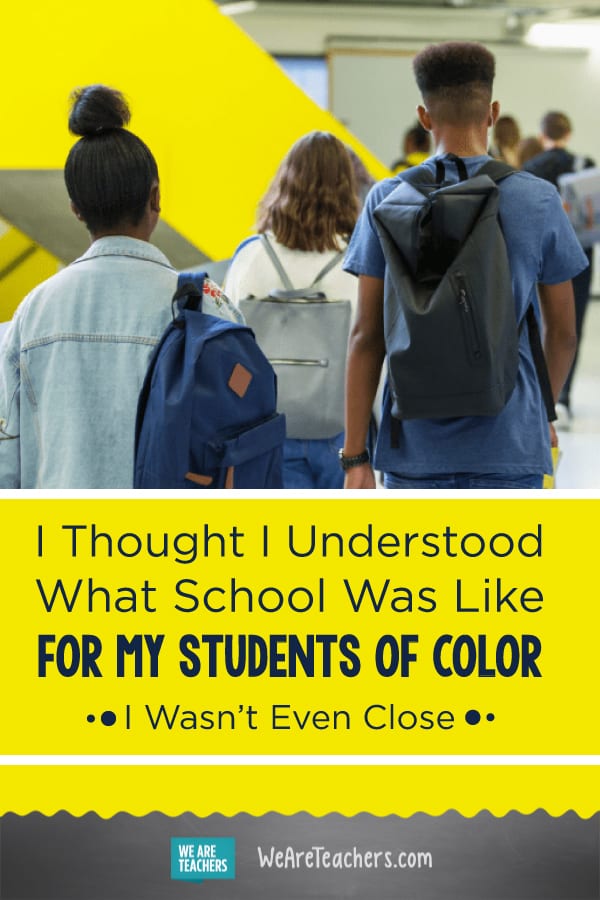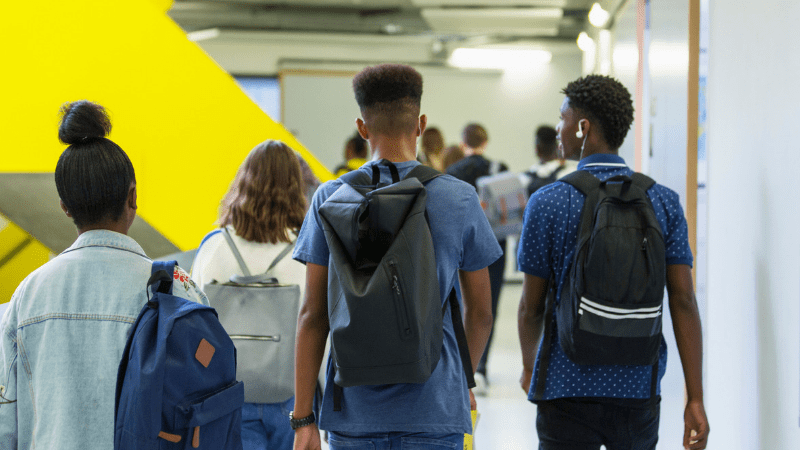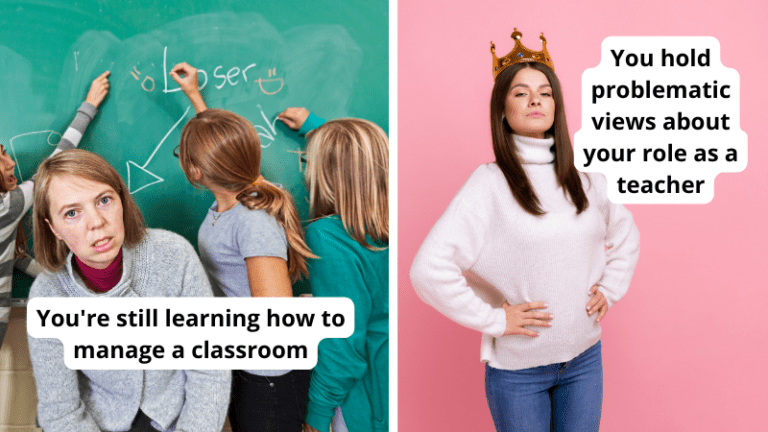Early in my teaching, a new teacher specialist for the district said she was going to videotape my lesson and review it with me.
“Wait,” I asked. “Am I going to be in it?”
“Uh, yes,” she said, smiling gently. “That’s kind of the point.”
I didn’t want to. The idea of seeing myself teaching made me feel exposed, defensive. Why should I have to do this? I thought my teaching was OK. If I’d examined these feelings more, I might have identified a deeper fear. A fear that the version of myself I would see on screen was even more of a failure than I’d thought.
Reviewing the footage was illuminating, but painful. There were things I saw in the video that I hadn’t even considered. My body language—arms crossed in front of me, head down, slouching—revealed my insecurity. I stuck to the same sections of the room, virtually ignoring an entire corner. Students were laughing and making jokes when I turned around, and one student slept through the whole mini-lesson.
I was embarrassed. And I had two ways of responding.
I could activate my defense mechanisms. I could deflect—make weak excuses, shift the blame to the kids themselves or the conditions I had to work in. And I could refuse to believe this was an accurate representation of me. I could even attack the credentials or intelligence of the district specialist.
Or, I could work on being better. I could remember that if my teaching wasn’t honoring the humans in my classroom and their intelligences, it was my job to change it.
Fast-forward to my fifth year of teaching, five years ago.
Though my teaching had improved in many ways, I was about to experience my most important shift yet. After work one day, I saw an article circulating on Facebook, “10 Ways Well-Meaning White Teachers Bring Racism Into Our Schools.” I had a reaction to reading this headline that was similar to how I’d responded when the district specialist said she would record my lesson: a mix of fear and curiosity, plus a healthy dose of preemptive defensiveness. This was not me.
Reading the article brought up emotions similar to those I felt while seeing myself teach. The more I learned about the racism white educators bring into the classroom, the more exposed I felt. Attacked. Defensive. I didn’t fit the picture of the racist I had in my head. And I desperately wanted to deflect and justify my own goodness, to run to the comment section to list out all my “But I can’t be racist because … !” reasons. Instead I chose to keep reading.
[contextly_auto_sidebar]
The more I read, the more I realized how wrong I’d been.
It was like putting on glasses and discovering I’d had absolutely terrible vision before—that the world and the self I thought I saw was wildly different from who I actually was, with all kinds of things I’d ignored, misinterpreted, or simply gotten wrong. Reading even further, I realized that this “new” world I was seeing is the similar to the world that has been painfully clear for other people, particularly my BIPOC (Black & Indigenous Person[s] of Color) friends, neighbors, students. They had known this world existed all along. Most of all, I was ashamed that it had taken me this long to understand these things. These truths had been there the whole time, and I had the ability, the privilege, to be ignorant of them.
Just as I realized that I had to change my teaching after watching myself on video, I knew, after reading that article, that I could no longer ignore the ways I was causing harm to BIPOC. Thinking you’re a good teacher doesn’t excuse bad teaching. Thinking you’re not racist doesn’t excuse racism.
I am choosing to change.
Through the work of Gloria Ladson-Billings, I learned that culturally relevant teachers invest in the communities they teach by living and/or purchasing goods and services there, “demonstrating their belief in the community as an important and worthwhile place in both their lives and the lives of the students.”
Through the work of Geneva Gay, I learned that culturally responsive teachers’ knowledge of other cultures and ethnicities needs to go beyond respecting differences to pursuing actual, factual knowledge of things I had no idea about, like which ethnic groups give priority to cooperative problem-solving, how different ethnic groups teach children to interact with adults, the ways that gender-role socialization occurs in different ethnic groups, and what all of that looks like in the classroom.
The more I read, the more I learn about what a truly diverse canon of literature looks like (like making sure our stories about other cultures are told by people actually within that culture instead of white people), teaching strategies that inadvertently value whiteness (like my emphasizing “correct” (read: “white”) pronunciation of words over vernacular), and the challenges faced by my BIPOC colleagues (like how they are more likely than I am to be seen as “aggressive” or “hostile” for defending themselves).
This is not some checklist I completed that made me magically free of racism.
These are very small steps in an ongoing process, one that I’ve only just started. And one that will demand continual education, self-evaluation, and listening to anyone—especially BIPOC—who asks that I do better.
I am not an expert on anti-racism work, but I am so, so grateful for the people out there who are, who know their work inside and out, and who share it so that BIPOC can live in and move between spaces where their humanity is honored. But we can’t build that world without white people acknowledging the ways we—all of us—are actively, even if not consciously, reifying racist ideas.
Below are just a few of the articles I’ve read that have helped shape my perspective and change my actions as a teacher. But it is nowhere near a complete list. Following that are more ways to educate yourself, whether you learn best in person, reading on your own, or engaging on social media.
I hope that other white educators out there choose to read and to listen.
We’ve got to do better.
Articles
1. “White Teachers Need to See Color: Here’s Why” by Joy Mohammed
A line that won’t leave me: “You need to see color because your black and brown students do not have the luxury to unsee color.”
2. “Confronting racism is not about the needs or feelings of white people” by Ijeoma Oluo
A line that won’t leave me: “If your anti-racism work prioritizes the ‘growth’ and ‘enlightenment’ of white America over the safety, dignity and humanity of people of color—it’s not anti-racism work. It’s white supremacy.”
3. “Dear White Teachers: You Can’t Love Your Black Students if You Don’t Know Them” by Bettina L. Love
A line that won’t leave me: “My K-12 schooling was filled with White teachers, who, at their core were good people but were unknowingly murdering my spirit with their lack of knowledge, care, and love of my culture.”
4. “Learning to Save Ourselves: When a book characterizes problematic ‘white savior’ tropes, how can it be used to effectively question those concepts with students?” by Christina Torres
A line that won’t leave me: “By teaching my students to question texts and their authors and to place both in historical context, I am also giving them the skills to question the media they consume today. I don’t want my students to feel like anyone has to come and save them.”
5. “Gamifying Settler Colonialism” by Benjamin Doxtdator
A line that won’t leave me: “One danger of poorly executed simulations of the darkest parts of our history is that white or otherwise privileged students may revel in what they see as the dramatic aspects of these situations—they may actually enjoy themselves.” (quote from Rebecca Onion writing for Slate)
More ways to become better educated:
- Follow hashtags like #EduColor, #DisruptTexts, and #CleartheAir
- Follow anti-racist accounts and experts on Twitter, such as Valeria Brown, Ijeoma Oluo, Christina Torres, Nikole Hannah-Jones, Kelly Wickham Hurst, Tricia Ebarvia, Julia E. Torres, Jason Reynolds, Lorena German, Dulce Marie-Flecha, Kim Parker, and Kaitlyn Popielarz
- Check out resources from Teaching Tolerance, the Zinn Education Project, and Rethinking Schools
- Start with these books (Just a heads up, WeAreTeachers may collect a share of sales from the links on this page. We only recommend items our team loves!): We Want to Do More Than Survive by Bettina Love and White Fragility: Why It’s So Hard for White People to Talk About Racism by Robin DiAngelo
We’d love to hear—how do you incorporate learning about anti-racist teaching into your professional development? Share your thoughts in our WeAreTeachers HELPLINE group on Facebook.
Plus, learn about the importance of mirrors and windows.


